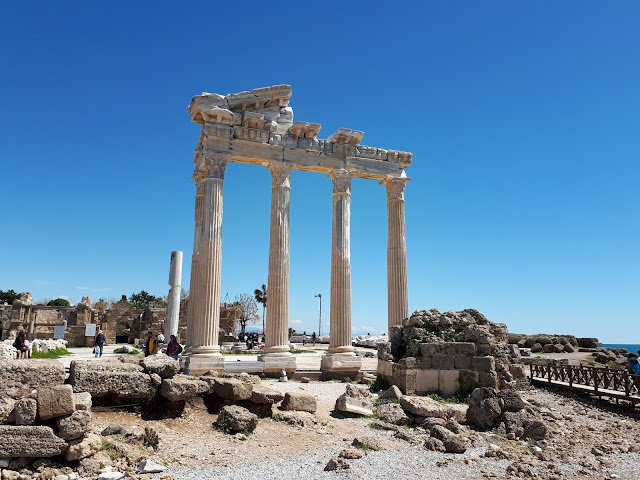Antalya Trip - 1
The rain had cleared and the morning started fresh, clear and sunny. The coming days would bring some welcome warm spring sunshine to momentarily banish the protracted drabness of the British winter.
The morning drive took us to the resort town of Side, 50km east of Antalya. The town dates back to the conquests of Alexander the Great and is characterized by the ruins of an old Roman settlement, and features an amphitheater that was well preserved and presented the focal point of the scattered remains.
Walking round the site in warm sunshine interspersed by an extremely laid-back lunch overlooking the bay was rather pleasant before commencing on a pedestrian wander around the ruins. A Whimbrel and Sandwich Tern were seen offshore.
It was rather quiet birdwise, but an adult Masked Shrike immediately captured my attention with two seen on our walk through the site.
A Little Owl sat on top of a remain of the old city wall before flying off as we approached.
A little bit of scrub revealed a Common Whitethroat, a Lesser Whitethroat (which were common throughout the trip) and an Olivaceous Warbler.
Crested Lark were in full song, another bird commonly seen on the trip.
The area around the amphitheatre proved to be fruitful. At least five Cretzchmar’s Bunting were present here, calling and flying around the ruins. An Ortolan was associating with them. Using the scope to scan the restricted area, a male Whinchat basked in the sun accompanied by a couple of Eastern Black-eared Wheatear.
From here, we headed over to Manavgat, and particularly the area alongside the river that winds through the region. A wide drivable rough gravel track was found without too much difficultly and heading along it brought the river closer to the road.
The morning drive took us to the resort town of Side, 50km east of Antalya. The town dates back to the conquests of Alexander the Great and is characterized by the ruins of an old Roman settlement, and features an amphitheater that was well preserved and presented the focal point of the scattered remains.
It was rather quiet birdwise, but an adult Masked Shrike immediately captured my attention with two seen on our walk through the site.
A surprise Purple Heron flew lazily over. An adult Woodchat Shrike sat alongside the second of the Masked Shrike, the two at odds with each other over what was apparently an ideally positioned bare tree.
A little bit of scrub revealed a Common Whitethroat, a Lesser Whitethroat (which were common throughout the trip) and an Olivaceous Warbler.
Crested Lark were in full song, another bird commonly seen on the trip.
The area around the amphitheatre proved to be fruitful. At least five Cretzchmar’s Bunting were present here, calling and flying around the ruins. An Ortolan was associating with them. Using the scope to scan the restricted area, a male Whinchat basked in the sun accompanied by a couple of Eastern Black-eared Wheatear.
These Starred Agama were out bathing in the sunshine.
Side is well worth the visit both for the historical offerings and for its wildlife. I can imagine deeper into the Spring there would be a wider selection of species given its southerly location and mix of scrub and arid habitats.
Pulling up and walking a short way to the rivers-edge disappointingly produced very little other than six flyover Glossy Ibis, and a singing Cetti’s Warbler. However, there was plenty to see on the other side of the road, half a dozen sparkling Whinchat, a Black-headed Wagtail, Long-legged Buzzard, Marsh Harrier, Eastern Black-eared Wheatear, four Tawny Pipit, a couple of Cretzchmar’s Bunting, a Sand Martin colony and the bird of the day, a magnificent adult Pallid Harrier that passed through with elegance and authority, a truly gripping sight.
Inexplicably, I failed to continue further along the track which I’m sure would have yielded more.
Driving back into Antalya, was a brutal experience, discovering very quickly the culture of the road where surface markings were merely cosmetic, death a minor inconvenience, and gaps between vehicles were aggresively frowned upon. It didn’t take me too long to get my elbows out and join in the fun. To take note, do not hire a car and stay in the old town of Antalya – the two are utterly incongruous and not for the faint hearted.
Driving back into Antalya, was a brutal experience, discovering very quickly the culture of the road where surface markings were merely cosmetic, death a minor inconvenience, and gaps between vehicles were aggresively frowned upon. It didn’t take me too long to get my elbows out and join in the fun. To take note, do not hire a car and stay in the old town of Antalya – the two are utterly incongruous and not for the faint hearted.













Comments
Post a Comment